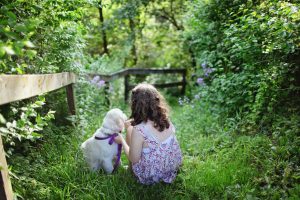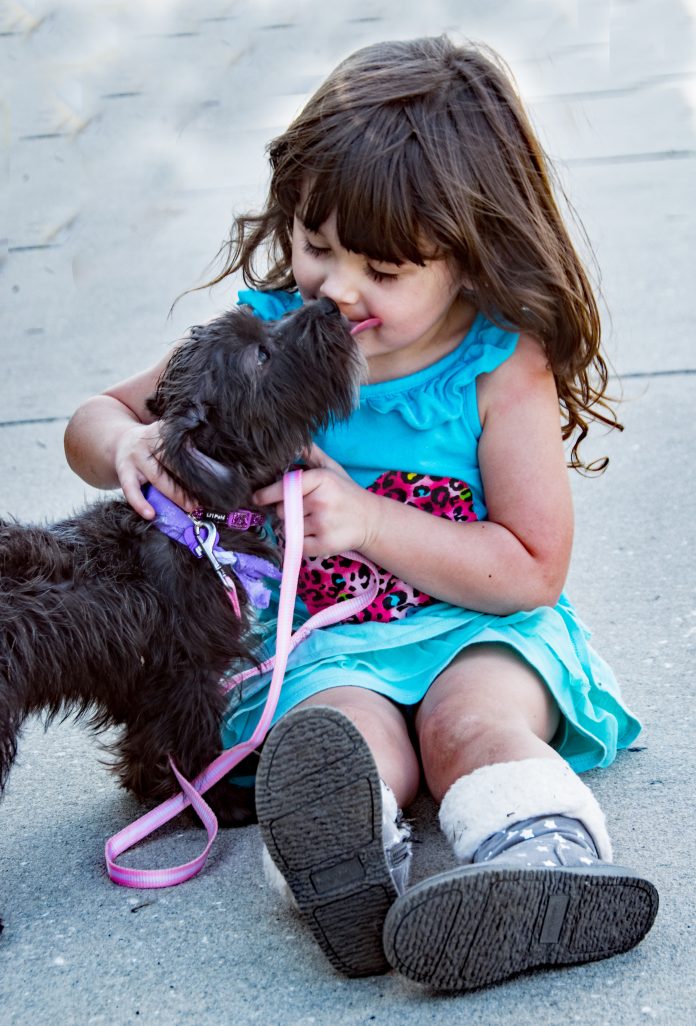For many toddlers it is fascinating to see dogs. They want to explore these furry creatures, approach them and love to stroke them. Parents can be unsettled, especially if they do not know the dog and its character. Even dog owners cannot say with certainty how their dog will react to this special toddler, because dogs do not behave 100% in every situation.
As a mother of a little daughter, dog owner and trainer, I have often seen how relaxed the relationship between toddler and dog can be when everyone involved meets with calm and respect. Provided they adhere to the general rules described below.
Always under supervision
Contact between toddler and dog should always be done with the full attention of an adult. This also applies if the toddler and dog have known each other for a long time and nothing has ever happened. Full attention means that the adult only pays attention and does not answer e-mails on the phone, on the phone or talk to other adults.
With the first contact with strange dogs, the toddler can sit on the lap of an adult or the adult can sit between the toddler and the dog. Excited dogs can also be secured with a leash by the owner to avoid jumping up or the like.
Who is approaching whom?
Ideally, it is the dog that is invited to approach the toddler. For example, by sitting on an adult’s lap and calling the dog. This should not be a must for the dog.
If the child crawls, stumbles or runs towards the dog, the dog feels threatened and restricted more quickly. It is important to avoid this. If the toddler is curious and wants to go to the dog all the time, an adult should position between the two, as shown above, in order to be able to intervene in time.
If a dog (regardless of whether foreign or familiar) comes running towards the child unleashed, it also makes sense to stand quietly in front of the child or between the dog and child.

The strange dog
Infants should know that they can never approach a strange dog on their own / never touch it!
First of all, the dog owner should always be asked whether approaching the dog is permitted at all. Then the dog should be “asked”. This takes the form that the dog can sniff the child without being petted directly. Since this is difficult for toddlers to understand when they actually want to cuddle, they should be protected by the arms of their parents. Only when the dog shows interest in the toddler it can pet under the supervision of an adult.
Note:
If the dog is simply stroked without sniffing it may be overwhelmed by the situation. It is possible that he feels frightened or feels spatially restricted. The reaction can vary depending on the dog.
Short interactions and retreat
For toddlers interacting with strange dogs, it is best for both sides if the encounters are short and relaxed. This enables toddlers and dogs to process what they have learned better than when they are together for a long time without a break or rest.
If parents and toddlers are visiting dog owners, the dog should have a retreat that is unreachable and taboo for the child. Here the dog can relax and feel safe after the encounter. Children’s grids or kennels / boxes offer opportunities here.
How can the toddler pet dogs and show their affection?
Toddlers like to hug; they hold on to whom they like; they love to kiss their loved ones and cry out for joy. Unfortunately, all of this is uncomfortable for most dogs. Fortunately, there are alternatives that are comfortable for both sides, provided the dog showed (as described above) that he would like to contact the child:
- Only stroke the dog with one hand (guided by the adult)
- The second hand can hold the adult’s hand to keep it busy
- Pause between petting and count to 5 to see if the dog enjoyed the interaction. If the dog comes closer or stays with the parent and toddler, you can continue petting with one hand
- Petting zones are the side of the dog and the side of the neck (not the head from above and not the tail or buttocks of the dog from behind)
- Kisses are sent by hand kiss and blown in the air towards the dog
- Stand to the side of the dog and do not lean over while he is being petted
- The dog can walk at any time and has enough space in all directions
Toddler and dog eat separately
Eating should always take place separately to ensure that the child does not go to the dog food to try it / to watch the dog eating up close and possibly encourage him to defend his food. It can also prevent the dog from stealing food from the child’s hands.
For example, during family meals, the dog can lie in its place, separate from the child, while the toddler is eating at the table. Alternatives are provided by a kennel with a positive structure or a children’s grid. The dog can be fed in its safety zone, which is taboo for the child.
Does wagging tails always mean that the dog is happy? Or how do I know that the dog is relaxed?
Contrary to popular belief, wagging tails does not always mean joy. Dogs wag their tails when excited. This can be friendly, but it does not have to be.
A lack of tension in the body is a sign of relaxation. The dog’s entire expressive behavior plays a role here:
- Snout including lips: hanging and snout slightly open
- Forehead: neither wrinkled nor smoothly tightened backwards
- Eyes: neither wide open with a white crescent moon around the pupils, nor drawn into slits
- Ears: neither strongly pulled forwards nor backwards
- missing hair in the back
- Tail: in neutral position, neither lowered nor raised
- Legs: not stiff
What is absolutely taboo when children meet dogs?
- Sit on the dog or ride on it
- Running wild / walking past dogs: this can cause fear or hunting behavior in dogs
- Jerky and rapid movements, such as waving your hands or kicking the dog
- Shouting: Dogs have a fine ear
- Drag games: If the dog has something in its mouth, the toddler should not pull on it
- Never disturb dogs while sleeping, eating or playing!
One last thing:
We adults are role models and toddlers imitate us. It is therefore important to teach the toddler how to treat animals respectfully and lovingly right from the start. This includes that animals are not toys and that they can withdraw at any time.











